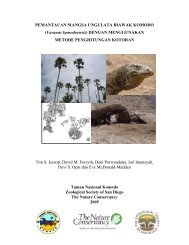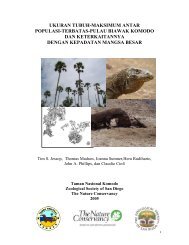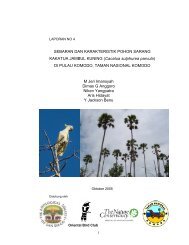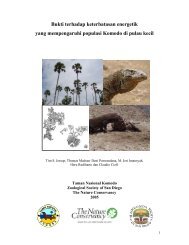Sustainable Financing of MPAs - Komodo National Park
Sustainable Financing of MPAs - Komodo National Park
Sustainable Financing of MPAs - Komodo National Park
Create successful ePaper yourself
Turn your PDF publications into a flip-book with our unique Google optimized e-Paper software.
1.2 <strong>Sustainable</strong> financing in Marine Protected Areas (<strong>MPAs</strong>)<br />
<strong>Sustainable</strong> financing mechanisms serve different purposes for <strong>MPAs</strong>. They could<br />
provide economic incentives, increase the cost effectiveness <strong>of</strong> management, support<br />
compatible enterprise development to provide alternative income to local communities and<br />
generate incentives and resources for conservation. They could also generate essential income<br />
to cover monitoring and operating costs. (Domeier 2002)<br />
Effective management <strong>of</strong> <strong>MPAs</strong> through sustainable financing mechanisms aims at<br />
preserving the biodiversity <strong>of</strong> marine and coastal species. For this purpose it also entails at<br />
developing a sense <strong>of</strong> ownership over the resource and products and livelihood alternatives<br />
that support marine conservation. (WCPA)<br />
1.3 Finance Mechanisms<br />
MPA goods and services have considerable economic benefits but also costs. An MPA<br />
needs to diversify revenues using a range <strong>of</strong> financial mechanisms and approaches to generate<br />
stable, predictable and sustained income for conservation. Relying on one or a few sources <strong>of</strong><br />
revenue is not sufficient to overcome the effects <strong>of</strong> fluctuations in income flows. In this<br />
paragraph the different finance mechanisms that could be used are described. The focus <strong>of</strong><br />
marine conservation <strong>of</strong> <strong>MPAs</strong> 1 is in this paper on revenue-raising mechanisms, not on moneysaving<br />
activities or economic incentive mechanisms. The mechanisms are categorized under<br />
three levels – international, national and local (United Nations Atlas <strong>of</strong> the Ocean 2005).<br />
Within each level the financing mechanisms are subdivided by their source <strong>of</strong> revenue.<br />
1.3.1 International level<br />
The main finance mechanisms at the international level are described below:<br />
• Multilateral development banks. Biodiversity conservation is increasingly benefiting<br />
from assistance from multilateral development banks, such as the World Bank and the<br />
Asian Development Bank. This funding is typically available only to governments as a<br />
loan for the establishment and maintenance <strong>of</strong> protected areas, <strong>of</strong>ten given in support<br />
<strong>of</strong> a national conservation plan. (United Nations Atlas <strong>of</strong> the Ocean 2005)<br />
• Grants and donations. A major source <strong>of</strong> funding for marine conservation is grants and<br />
donations from bilateral and multilateral donor agencies, foundations, NGOs, private<br />
sector companies, and individuals. Donors supply short-term funding which can cover<br />
specific conservation needs in protected areas. (Quintela et al. 2004)<br />
- The international donor agencies include multilateral agencies such as the<br />
European Union (EU), United Nations Food and Agricultural Organization<br />
(FAO), Global Environment Facility (GEF) 2 , United Nations Development<br />
1 In Indonesia, conservation organizations such as the CCIF and TNC are testing the concept in the marine environment. TNC is developing<br />
an eco-tourism concession through a joint venture with an Indonesian company, Putri Naga <strong>Komodo</strong>, which will operate in and around<br />
<strong>Komodo</strong> NATIONAL PARK.<br />
2 The Global Environment Facility (GEF) was established to address biodiversity loss (where it acts as the funding arm <strong>of</strong> the CBD) and the<br />
degradation <strong>of</strong> international waters and brings together 166 member governments, leading development institutions, the scientific community,<br />
6






